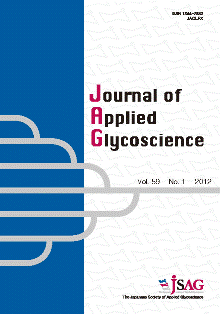All issues

Volume 59 (2012)
- Issue 4 Pages 139-
- Issue 3 Pages 97-
- Issue 2 Pages 51-
- Issue 1 Pages 1-
Volume 59, Issue 4
Displaying 1-4 of 4 articles from this issue
- |<
- <
- 1
- >
- >|
Regular Papers
-
Junko Matsuki, Riki Shiroma, Masakazu Ike, Ken Tokuyasu2012Volume 59Issue 4 Pages 139-144
Published: November 20, 2012
Released on J-STAGE: November 28, 2012
Advance online publication: October 04, 2012JOURNAL FREE ACCESSA lime pretreatment process, calcium capturing by carbonation at room temperature (RT-CaCCO) that is used for enzymatic saccharification, was applied in order to recover glucose from whole-crop rice powders whose starch content was 26.4% of the total dry weight. Only 39.6% of the total starch was saccharified by enzymatic saccharification with the standard RT-CaCCO process, indicating the need for further optimization of the process. The effects of Ca(OH)2 concentration, mild heat treatment (MHT) and enzyme supplementation were evaluated for improved glucose release. Gelatinization enthalpy showed that MHT after RT-CaCCO (RT-MHT-CaCCO) with increased addition of Ca(OH)2 from 10 to 30% of the whole dry sample weight was reasonable in promoting sufficient disruption of starch structure, because of the increased absorption of Ca(OH)2 by the straw. The addition of α-amylase from Bacillus sp. improved the total glucose release up to 79.8% of the theoretically recoverable glucose, in which 87.0% of the total starch was saccharified. Bacillus α-amylase was probably more favorable for hydrolyzing alkali-treated starch and for producing substrates for amyloglucosidase compared to α-amylase found in the enzyme preparation of the standard RT-CaCCO process. The thorough alkali- gelatinization of starch and an appropriate combination of enzymes is crucial to apply the RT-CaCCO process to starch-rich whole-crop samples for efficient glucose recovery.View full abstractDownload PDF (735K) -
Shusaku Izumi, Tomomi Hirota, Kazuhiro Yoshinaga, Jun-ichi Abe2012Volume 59Issue 4 Pages 145-151
Published: November 20, 2012
Released on J-STAGE: November 28, 2012
Advance online publication: October 04, 2012JOURNAL FREE ACCESS1,5-Anhydro-D-fructose (AF) was added to cultures of Saccharomyces cerevisiae and converted to 1,5-anhydro-D-glucitol (AG) and 1,5-anhydro-D-mannitol (AM) by two NADPH-dependent 1,5-anhydro-D-fructose reductase (AFR). The partial amino acid sequence of AFR (AG-forming; AFR-AG) matched with that of D-arabinose dehydrogenase (ArDH). AFR-AG showed reducing activities toward several organic compounds with highest reducing activity toward AF. In addition, it showed oxidizing activity toward several monosaccharides such as D-arabinose and L-xylose. The substrate specificity (reducing activity) and several amino acid sequence motifs of the enzyme resembled those of AFR from mammals. From these enzymatic properties, we concluded that this enzyme should be called AFR rather than ArDH. AFR (AM-forming; AFR-AM) was classified as an oxidoreductase encoded by the ymr315w gene. There was no conserved sequence between AFR-AG and AFR-AM suggesting the existence of two different systems in yeast for converting AF. The AFR-AM (YMR315W-protein) enzyme showed reducing activity only for AF, did not have any oxidizing activity, and has sequence homology only to enzymes of bacterial origin. Finally, we demonstrated an in vitro NADP-NADPH cycling system using the AFR-AG ability to reduce AF and oxidize L-xylose. AG production using low concentration of NADPH increased with the addition of L-xylose.View full abstractDownload PDF (1494K) -
Hitoshi Sato, Saeko Yokochi, Terumi Kasama, Takako Hirano, Wataru Haka ...2012Volume 59Issue 4 Pages 153-160
Published: November 20, 2012
Released on J-STAGE: November 28, 2012
Advance online publication: October 04, 2012JOURNAL FREE ACCESS
Supplementary materialWe used Aspergillus oryzae mycelia containing a transfructosylation-catalyzing enzyme, β-fructofuranosidase, to establish a methodology for the large-scale production of N-acetylsucrosamine in a column bioreactor. A. oryzae mycelia containing the enzyme were grown in liquid culture and immobilized on Perlite macro-porous amorphous volcanic glass beads, which were then packed into the column reactor. Passing a solution containing 10% sucrose and 20% 2-acetamido-2-deoxy-D-glucose through the reactor resulted in the steady production of N-acetylsucrosamine for at least 30 days and provided a yield of at least 27.5% (molar yield) from sucrose. N-Acetylsucrosamine was isolated easily and in high yield (from 83.4 to 96.9%) from the column reactor eluate after preprocessing by yeast β-fructofuranosidase or by whole yeast cells.View full abstractDownload PDF (1981K)
Notes
-
Teruko Konishi, Ikuko Nakata, Yuto Miyagi, Masakuni Tako2012Volume 59Issue 4 Pages 161-163
Published: November 20, 2012
Released on J-STAGE: November 28, 2012
Advance online publication: June 08, 2012JOURNAL FREE ACCESSCaulerpa lentillifera is green alga which is eaten and known as green sea caviar in Japan. After extraction with 70% ethanol, chloroform/methanol (1:1, v/v), aceton and hot water, polysaccharide was extracted by 24% KOH and collected as KOHP. KOHP became water-insoluble after neutralization with acetic acid. The results of neutral sugar composition analysis showed that the KOHP was mainly composed of xylose. Methylation analysis showed that the KOHP mainly consists of 1,3-linked xylose. The result of the optical rotation analysis indicated that the KOHP was composed of β-linked sugar. These results indicated that polysaccharide in C. lentillifera extracted by 24% KOH is relatively pure β-1,3-xylan.View full abstractDownload PDF (550K)
- |<
- <
- 1
- >
- >|